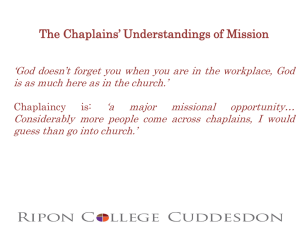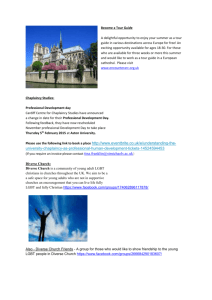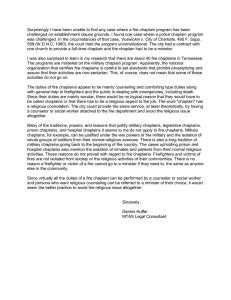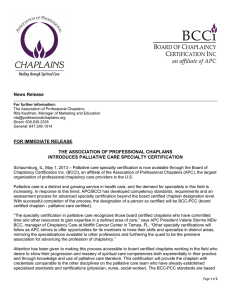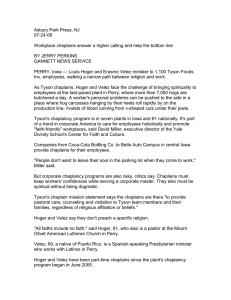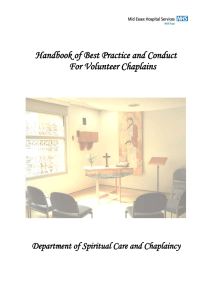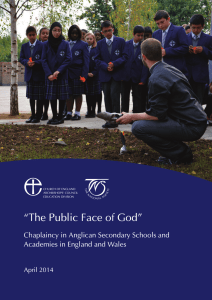Religion and Spirituality in Hospitals: An
advertisement
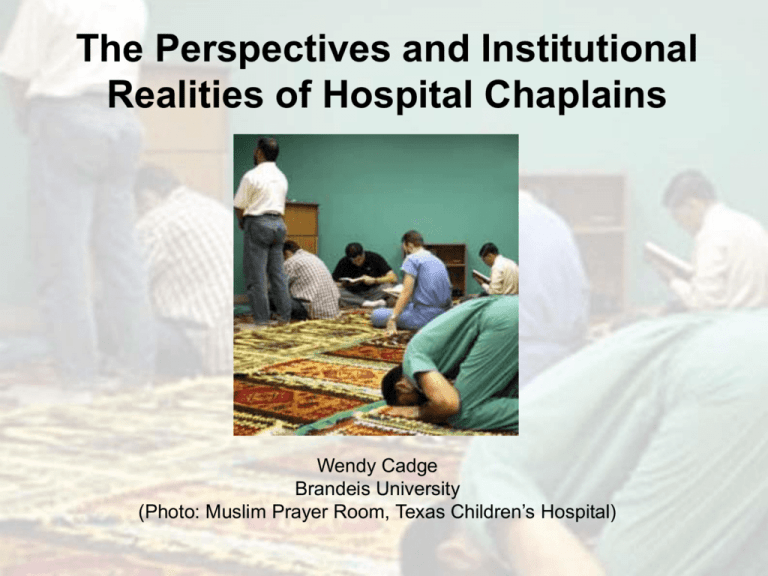
The Perspectives and Institutional Realities of Hospital Chaplains Wendy Cadge Brandeis University (Photo: Muslim Prayer Room, Texas Children’s Hospital) Fraction of Articles in PubMed Related to Religion/Spirituality 0.4 0.35 0.25 Religion 0.2 Spirituality Religion or Spirituality 0.15 0.1 0.05 0 19 50 19 55 19 60 19 65 19 70 19 75 19 80 19 85 19 90 19 95 20 00 20 05 % of all PubMed articles 0.3 Year JCAHO 2009 Standards “The hospital respects the patient’s cultural and personal values, beliefs and preferences.” “The hospital accommodates the patient’s right to religious and other spiritual services.” Other regulations pertain to food; education; care for substance abuse, emotional and behavioral issues; end-of-life care, etc. (See: http://www.uphs.upenn.edu/pastoral/resed/JCAHOrefs.pdf) Recent Statistics • 70-85% of Americans regularly pray for good or better health for themselves or a family member • 72% believe God can cure people given no chance of survival by medical science • 60% of the public and 20% of medical professionals think someone in a persistent vegetative state can be saved by a miracle (Jacobs, Burns, and Jacobs 2008). Paging God: Religion in the Halls of Medicine (Working Outline) • • • • • Preface c.1 Introduction c.2 Religion in the History and Development of Hospitals c.3 From Symbols to Silence: The Design and Use of Hospital Chapels c.4 Spirituality and Hope….The Contributions of Hospital Chaplains c.5 Chaplains at Work: Existing Institutional Arrangements c.6 Religion and Spirituality in Intensive Care: Staff’s Perspectives and Professional Responses c.7 Why Sickness and Death: How Intensive Care Unit Staff Personally Make Meaning c.8 Managing Death: The Personal and Institutional Dirty Work of Chaplains c.9 Conclusions • Methodological Appendix • • • • • Chaplaincy Service in U.S. Hospitals (1980 - 2003) 20 03 20 02 19 93 19 92 19 85 19 84 19 83 19 82 19 81 19 80 100% 90% 80% 70% 60% 50% 40% 30% 20% 10% 0% (Source: Cadge, Wendy, Jeremy Freese, and Nicholas Christakis. 2008. “Hospital Chaplaincy in the United States: A National Overview.” Southern Medical Journal. 101(6):626-630.) Data Presented Here • Interviews with the director and one staff chaplain at the 17 most highly ranked hospitals according to U.S. News and World Report 2004 (N=37 interviews) • In-depth study of one of these 17 chaplaincy departments – attended meetings and retreats, interviewed the 32 staff and volunteers. • The majority of directors were male, Protestant, white, and in their mid-60s. Slightly more staff chaplains were female, not-Protestant, and younger. Logic of Analysis • Essential Work? • Consistent Work? • Ideal Types: – where situated administratively – whether paid by the hospital – training required to be hired – part of protocols – how volunteers and CPE students are included in the department. • Ideal Types: Professional (N=4), Transitional (N=3), Traditional (N=10) Explaining Variation • Departments started by people within hospitals or with financial support from hospitals tend to fall into professional or transitional ideal types • Departments in professional and transitional ideal types have directors who learned to speak the language of the healthcare system • Departments in professional and transitional ideal types have continually broadened their visions, generally away from an exclusive focus on CPE.

